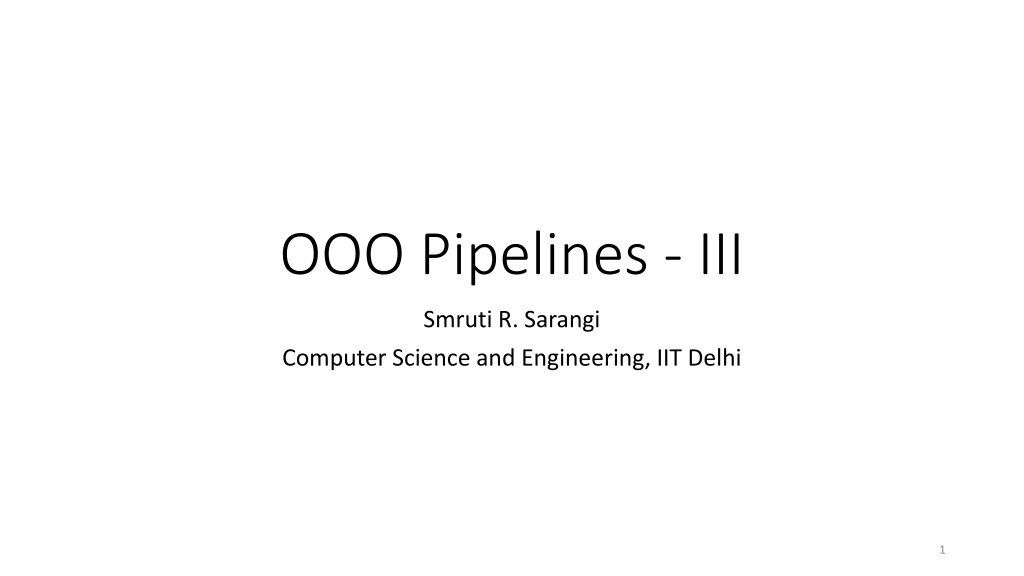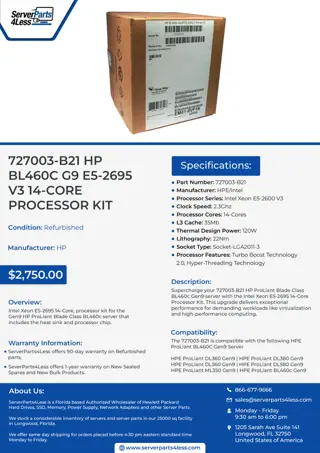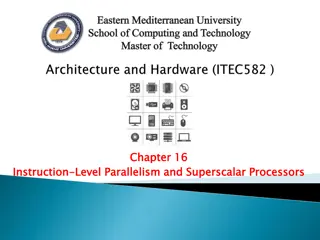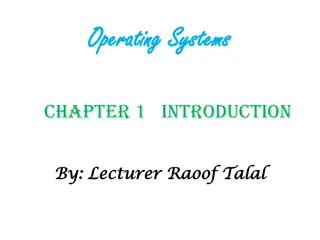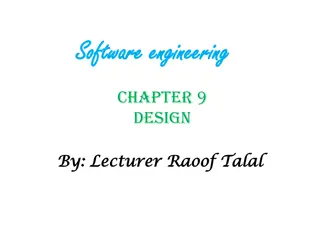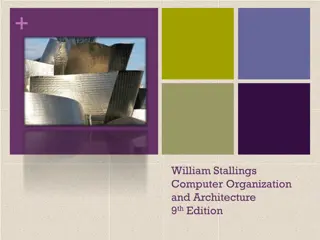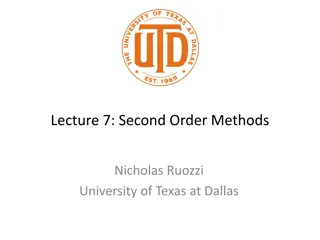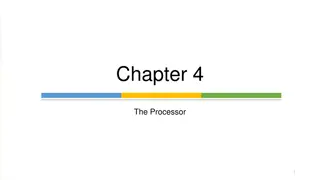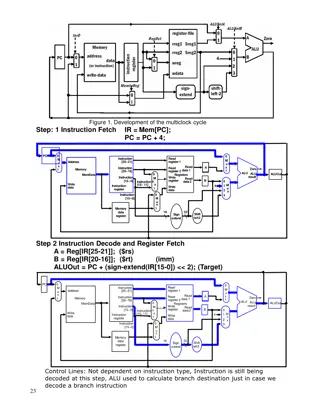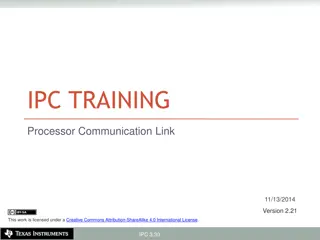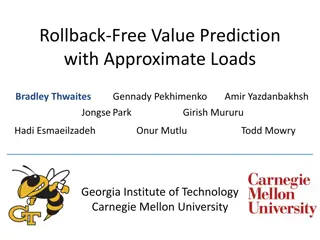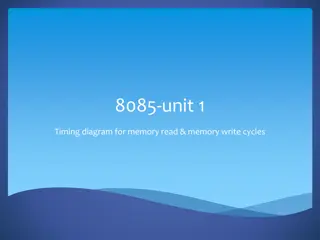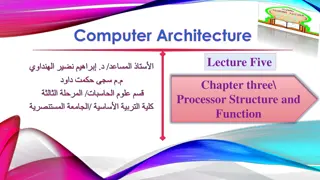Out-of-Order Processor Design Exploration
Explore the design of an Out-of-Order (OOO) processor with an architectural register file, aggressive speculation, and efficient replay mechanisms. Understand the changes to renaming, dispatch, wakeup, bypassing, register writes, and commit stages. Compare Processor Register File (PRF) based design with Architectural Register File (ARF) based design in terms of performance and state management.
Download Presentation

Please find below an Image/Link to download the presentation.
The content on the website is provided AS IS for your information and personal use only. It may not be sold, licensed, or shared on other websites without obtaining consent from the author.If you encounter any issues during the download, it is possible that the publisher has removed the file from their server.
You are allowed to download the files provided on this website for personal or commercial use, subject to the condition that they are used lawfully. All files are the property of their respective owners.
The content on the website is provided AS IS for your information and personal use only. It may not be sold, licensed, or shared on other websites without obtaining consent from the author.
E N D
Presentation Transcript
OOO Pipelines - III Smruti R. Sarangi Computer Science and Engineering, IIT Delhi 1
Contents OOO Processor with an Architectural Register File Aggressive Speculation and Replay Uses of Aggressive Speculation 2
Let us now look at a different kind of OOO processor Instead of having a physical register file, let us have an architectural register file(ARF) A 16-entry architectural register file that contains the committed architectural state. Commit Time Rest remains the same Committed State ARF Decode Renaming Register Write IW ROB Temporary State Write back temp. results 3
Changes to renaming Entry in the RAT (register address translation) table Entry in the RAT table ROB id ROB/RF bit ROB/RF bit 1 (value in the ROB), 0 (value in the RF) Use the ROB if the ROB/RF bit indicates that the value is in the ROB Entry in the ROB: (ready bit indicates if the value is in the ROB (1) or being generated in the pipeline (0)) Entry in the ROB Instruction ready dest value dest 4
Changes to Dispatch and Wakeup Each entry in the IW now stores the values of the operands Reason: We will not be accessing the RF again What is the tag in this case? It is not the id of the physical register. It is the id of the ROB entry. What else? Along with the tag we need to broadcast the value of the operand also if we will not get the value from the bypass network This will make the circuit slower 5
Changes to Wakeup, Bypass, Reg. Write and Commit We can follow the same speculative wakeup strategy and broadcast a tag (in this case, id of ROB entry) immediately after an instruction is selected Instructions directly proceed from the select unit to the execution units All tags are ROB ids. After execution write the result to the ROB entry Commit is simple. We have always the architectural state in the ARF. We just need to flush the ROB. 6
PRF based design vs ARF based design + points in the PRF based design A value resides in only a single location (PRF). Multiple copies of values are never maintained. In a 64-bit machine, a value is 64 bits wide. Each entry in the IW is smaller (values are not saved). The broadcast is also narrower Restoring state is complicated + points in the ARF based design Recovery from misspeculation is easy We do not need a free list Values are maintained at multiple places (ARF, ROB, IW) 7
Contents OOO Processor with an Architectural Register File Aggressive Speculation and Replay Uses of Aggressive Speculation 8
Aggressive Speculation Branch prediction is one form of speculation If we detect that a branch has been mispredicted Solution: flush the pipeline This is not the only form of speculation Another very common type: load latency speculation Assume that a load will hit in the cache Speculatively wakeup instructions Later on if this is not the case: DO SOMETHING 9
Replay Flushing the pipeline for every misspeculation is not a wise thing Instead, flush a part of the pipeline (or only those instructions that have gotten a wrong value) Replay those instructions once again (after let s say the load completes its execution) When the instructions are being replayed, they are guaranteed to use the correct value of the load 10
Two methods of replaying Method 1: Keep instructions that have been issued in the issue queue (see reference) verification status IW Pipeline Stages Verify remove from issue queue if verified 11
Two methods of replaying - II Move the instructions to a dedicated replay queue after issue Once an instruction is verified remove it from the replay queue verification status Verify Pipeline Stages IW Replay queue remove from replay queue if verified remove from the issue queue 12
Non-Selective Replay Trivial Solution: Flush the pipeline between the schedule and execute stages Smarter Solution It is not necessary to flush all the instructions between the schedule and execute stages Try to reduce the set of instructions Define a window of vulnerability (WV) for n cycles after a load is selected. A load should complete within n cycles if it hits in the d-cache and does not wait in the LSQ However, if the load takes more than n cycles, we need to do a replay Algorithm: Kill all 13
Instruction Window Entry Broadcast bus Kill wire tag ready bit Timer When an instruction wakes up, we set the timer to n Every cycle it decrements (count down timer) Once it becomes 0, we can conclude that this instruction will not be squashed 14
More about Non-Selective Replay We attach the expected latency with each instruction packet as it flows down the pipeline Wherever there is an additional delay (such as cache miss) Time for a replay Set the kill wire Each instruction window entry that has a non-zero count, resets its ready flag We now have a set of instructions that will be replayed For some such instructions tags will be broadcast Not for all (see the next slide) 15
Example ld r1, 8[r4] add r2, r1, r1 sub r4, r3, r2 xor r5, r6, r7 Assume that the load instruction misses in the L1 cache The add, sub, and xor instructions will need to be squashed, and replayed For the add and sub instructions tag will be broadcast What about the xor instruction? We need to broadcast additional tags 16
Delayed Selective Replay Let us now propose an idea to replay only those instructions that are in the transitive-closure of the misspeculated load Let us extend the non-selective replay scheme At the time of asserting the kill signal, plant a poison bit in the destination register of the load Propagate the bit along the bypass paths and through the register file If an instruction reads any operand whose poison bit is set, then the instruction s poison bit is also set. When an instruction finishes execution 17
Delayed Selective Replay - II When an instruction finishes execution Check if its poison bit is set. If yes, squash it If no, re-enable the instruction and broadcast a message to mark the instruction ready Issues with this scheme It is effective, but, assumes that we know the value: n This might not be possible all the time Dependent instructions get the verification status by timing out. This creates some false dependences also 18
Token Based Selective Replay Let us use a pattern found in most programs: Most of the misses in the data cache are accounted for by a relatively small number of instructions 90/10 thumb rule 90% of the misses are accounted for by 10% of instructions Predictor Given a PC, predict if it will lead to a d-cache miss Use a predictor similar to a branch predictor at the fetch stage PC Output Prediction Table 19
After Predicting d-cache Misses Instructions that are predicted to miss, will have a non-deterministic execution time (most likely) and lead to replays (set S1) Other instructions will not lead to replays (most likely) (set S2) Let us consider an instruction in set S1 At decode time, let the instruction collect a free token Save the id of the token in the instruction packet Example: assume the instruction: ld r1, 4[r4] is predicted to miss Save the id of the token in the instruction packet of this instruction Say that the instruction gets token #5 This instruction is the token head for token #5 Let us propagate this information to all the instructions dependent on the load If this load fails, all the dependent instructions fail as well 20
Structure of the Rename Table phy. reg r1 rename table id of token tokenVec If an instruction is a token head, we save the id of the token that it owns Assume we have a maximum of N tokens. tokenVec is a N-bit vector For the token head instruction, if it owns the ith token, set the ith bit to true in tokenVec 21
While reading the rename table ... add r1, r2, r3 Read the tokenVecs of the source operands Merge the tokenVecs of the source operands Save the merged tokenVec for the destination register (in the rename table) 22
After execution After the token head instruction completes execution, see if it took additional cycles If YES, broadcast the token id to signal a replay (Case 1) If NO, broadcast the token id to all the instructions. They can turn the corresponding bit off. (Case 2) Case 2 Case 1 Replay 23
Instructions in S2 Assume an instruction that was not predicted to miss actually misses No token is attached to it Solution: Squash all instructions after this instruction from the IW Re-insert them from the ROB Expensive Operation The replay mechanism is cheaper than a full scale pipeline flush 24
Contents OOO Processor with an Architectural Register File Aggressive Speculation and Replay Uses of Aggressive Speculation 25
What can we predict? Data obtained from the L1 cache Dependences between load-store instructions Load instructions that will most likely read data from the L1 cache and have a cache hit ALU results 26
Why can we predict? (Lipasti and Shen, 96) Data redundancy Bit masking operations Trivial operands and constants Results of error checking Code for virtual functions Glue code Register spill code 27
How to Predict? PC PC Confidence Confidence Table (uses sat. counters) Prediction Predictor Table First, use the confidence table to find out if it makes sense to predict Simultaneously, make a prediction using a predictor table (value, memory dependence, ALU result) Predictor table can contain 1 value, or the last kvalues Make a prediction, and use it if it has high confidence Update both the tables when the results are available If needed recover with a replay/flush mechanism 28
THE END 29
